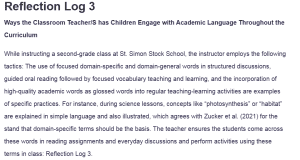Reflection Log 3
Ways the Classroom Teacher/S has Children Engage with Academic Language Throughout the Curriculum
While instructing a second-grade class at St. Simon Stock School, the instructor employs the following tactics: The use of focused domain-specific and domain-general words in structured discussions, guided oral reading followed by focused vocabulary teaching and learning, and the incorporation of high-quality academic words as glossed words into regular teaching-learning activities are examples of specific practices. For instance, during science lessons, concepts like “photosynthesis” or “habitat” are explained in simple language and also illustrated, which agrees with Zucker et al. (2021) for the stand that domain-specific terms should be the basis. The teacher ensures the students come across these words in reading assignments and everyday discussions and perform activities using these terms in class: Reflection Log 3.
What I Noticed Works Well
The consistent use of child-friendly definitions and engaging methods, such as vocabulary-focused shared reading routines, works exceptionally well. It is equally crucial to make academic vocabulary easily understandable and easy for these young learners to recall, as pointed out by Zucker et al., 2021. Moreover, the teacher monitors the use of words by using objects such as word walls. She rejoices when the students use these terms while talking and promotes word consciousness.
This practice is also consistent with the classroom’s inclusiveness, as described in Reflection Log 1, where learners bring multilingual resources to the classroom. Likewise, in the Interrogative Activities described in Reflection Log 2 of this reflection log, several questioning practices enable students to use and access academic language in real and purposeful contexts.
What I Think Could be Added and/or Done Differently
While the methods are effective, opportunities exist to enhance academic language engagement. Encouraging Student-Led Questions would allow students to ask questions about new vocabulary, which can foster curiosity and deeper understanding (Chouinard et al., 2007). Leveraging Peer Collaboration would help incorporate activities like ‘think-pair-share’ for vocabulary discussions, enabling students to explore and use academic terms collaboratively, ensuring equitable participation (Guenther & Abbott, 2024). As suggested by Zucker et al. (2021), using words with numerous meanings would enhance vocabulary development and demonstrate the flexibility of words with different meanings.
Reflection
In my future classroom, I plan to implement a vocabulary-rich environment by using Interactive Word Walls that include visuals and student-generated definitions, encouraging ownership and regular use of academic terms. Facilitating Structured Vocabulary Games such as “word charades” or “context clues scavenger hunts” will make learning interactive and fun.
References
Guenther, A. R., & Abbott, C. M. (2024). Think-Pair-Share: Promoting Equitable Participation and In-Depth Discussion. PRiMER: Peer-Reviewed Reports in Medical Education Research, 8. https://doi.org/10.22454/PRiMER.2024.444143
Souto-Manning, M., & Martell, J. (2016). Reading, writing, and talk: Inclusive teaching strategies for diverse learners, K–2. Teachers College Press.
Zucker, T. A., Cabell, S. Q., & Pico, D. L. (2021). Going nuts for words: Recommendations for teaching young students academic vocabulary. The Reading Teacher, 74(5), 581-594. https://doi.org/10.1002/trtr.1967
ORDER A PLAGIARISM-FREE PAPER HERE
We’ll write everything from scratch
Question 
I HAVE ATTACHED MY REFLECTION LOGS 1 & 2 THAT I GOT DONE BY YOU GUYS FOR YOUR REVIEW. PLEASE REVIEW BOTH BEFORE STARTING THIS ASSIGNMENT. ONCE YOU REVIEW THOSE YOU ARE GOING TO FOLLOW MY PROFESSORS INSTRUCTIONS BELOW AND YOU ARE GOING TO CONNECT IT TO MY CLASS READINGS WHICH I ATTACHED TO THE ORDER.

Reflection Log 3
Reflection Log 3 Topic: (Academic Language) Discuss the ways in which the classroom teacher/s has children engage with academic language throughout the curriculum. Focus on specific examples. Then, answer the following questions using pertinent readings from session 7 to evaluate the extent to which the classroom teacher/s use methods that help children engage with academic language:
- What do you notice works well? Explain why.
- What do you think could be added and/or done differently? Explain why.
- Reflect on how you would do this in your class or in the future. Be specific.
